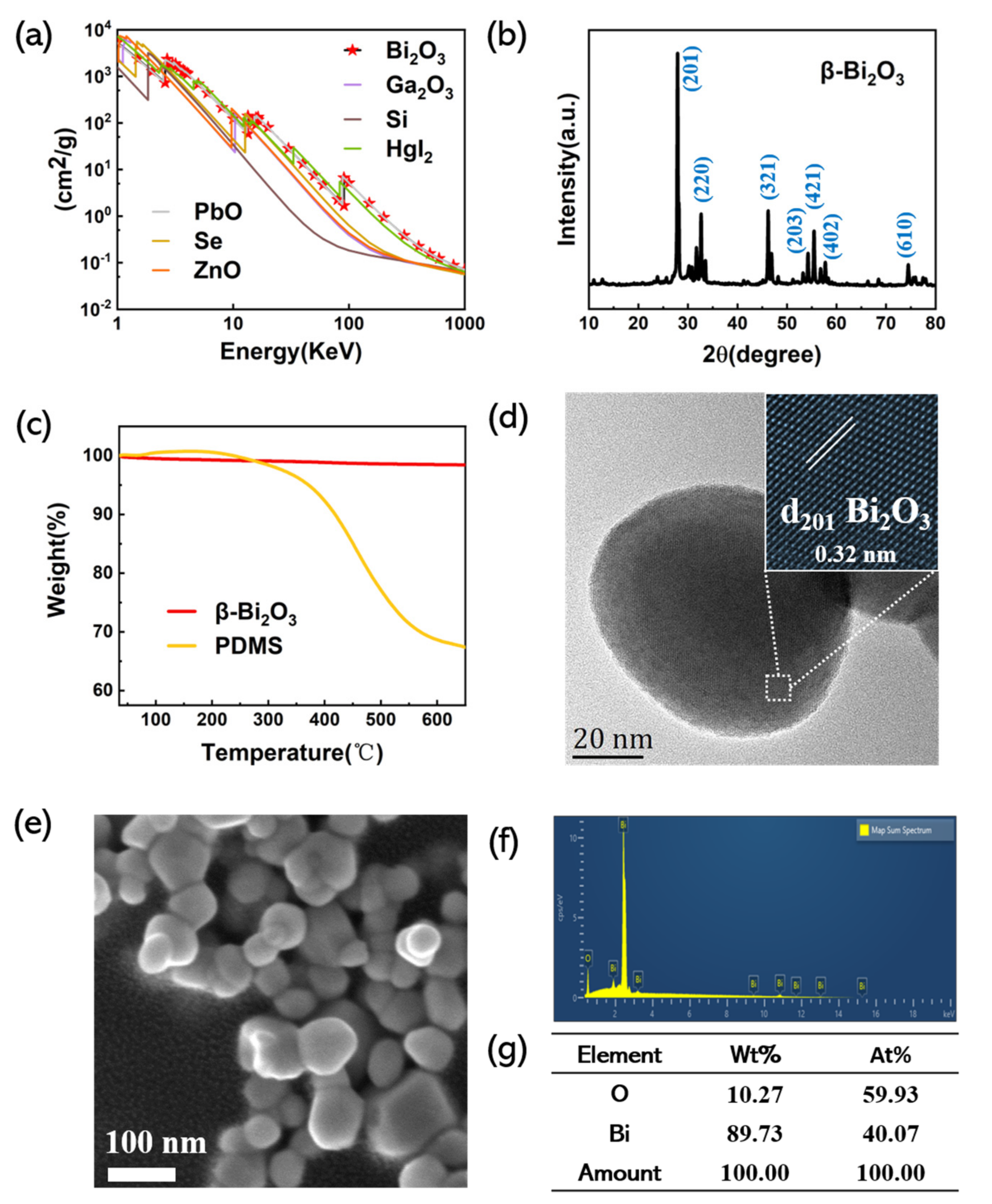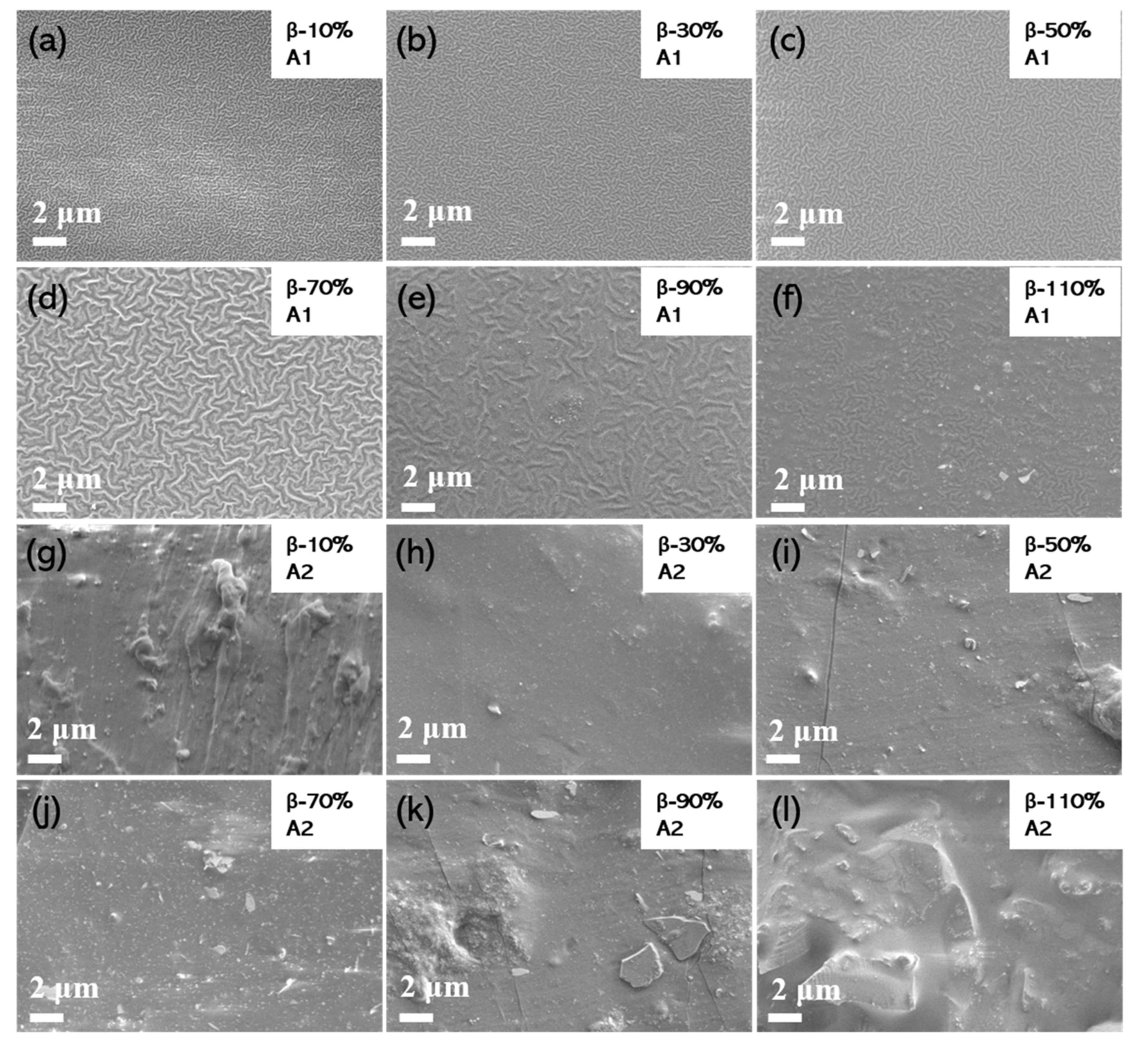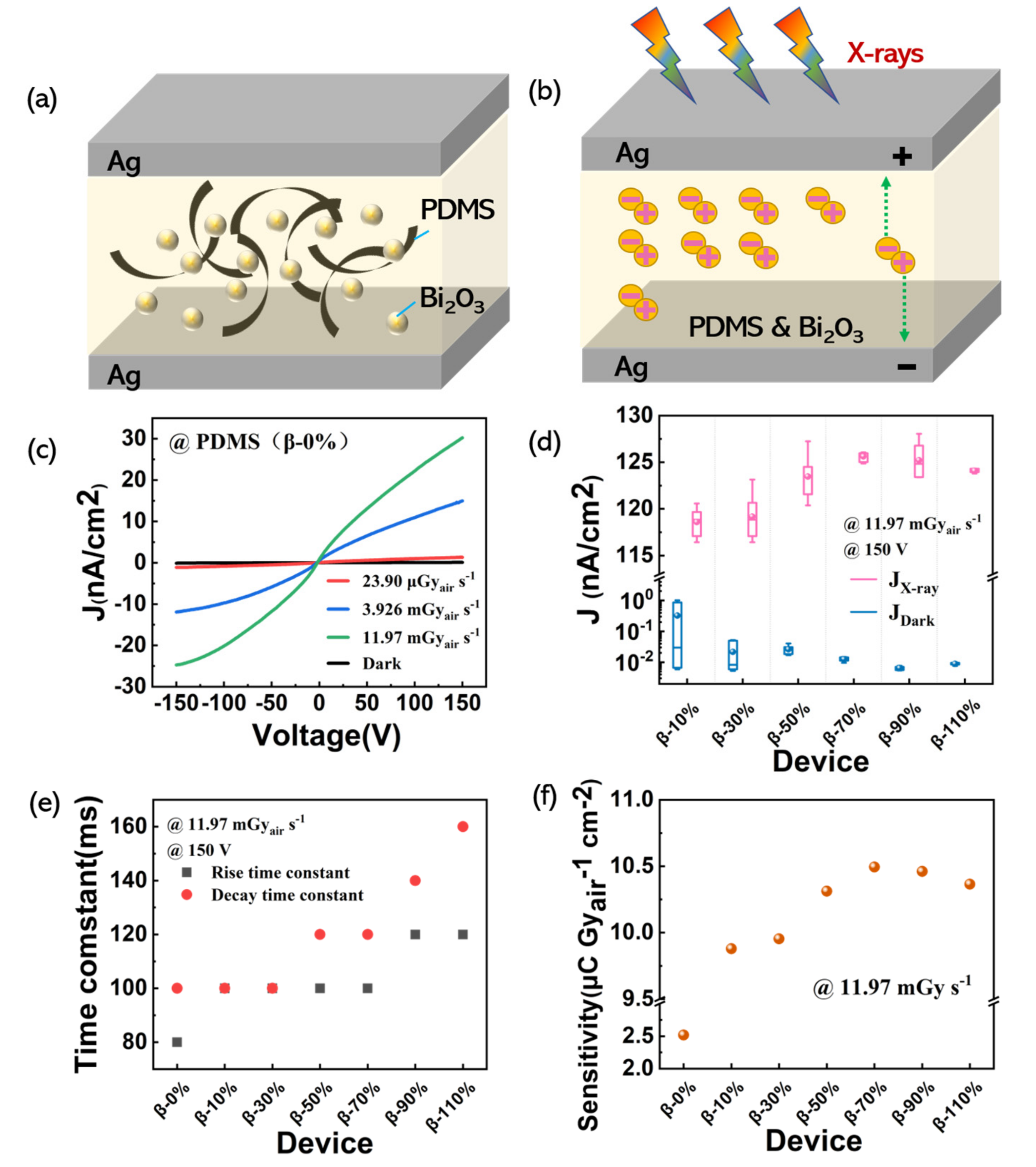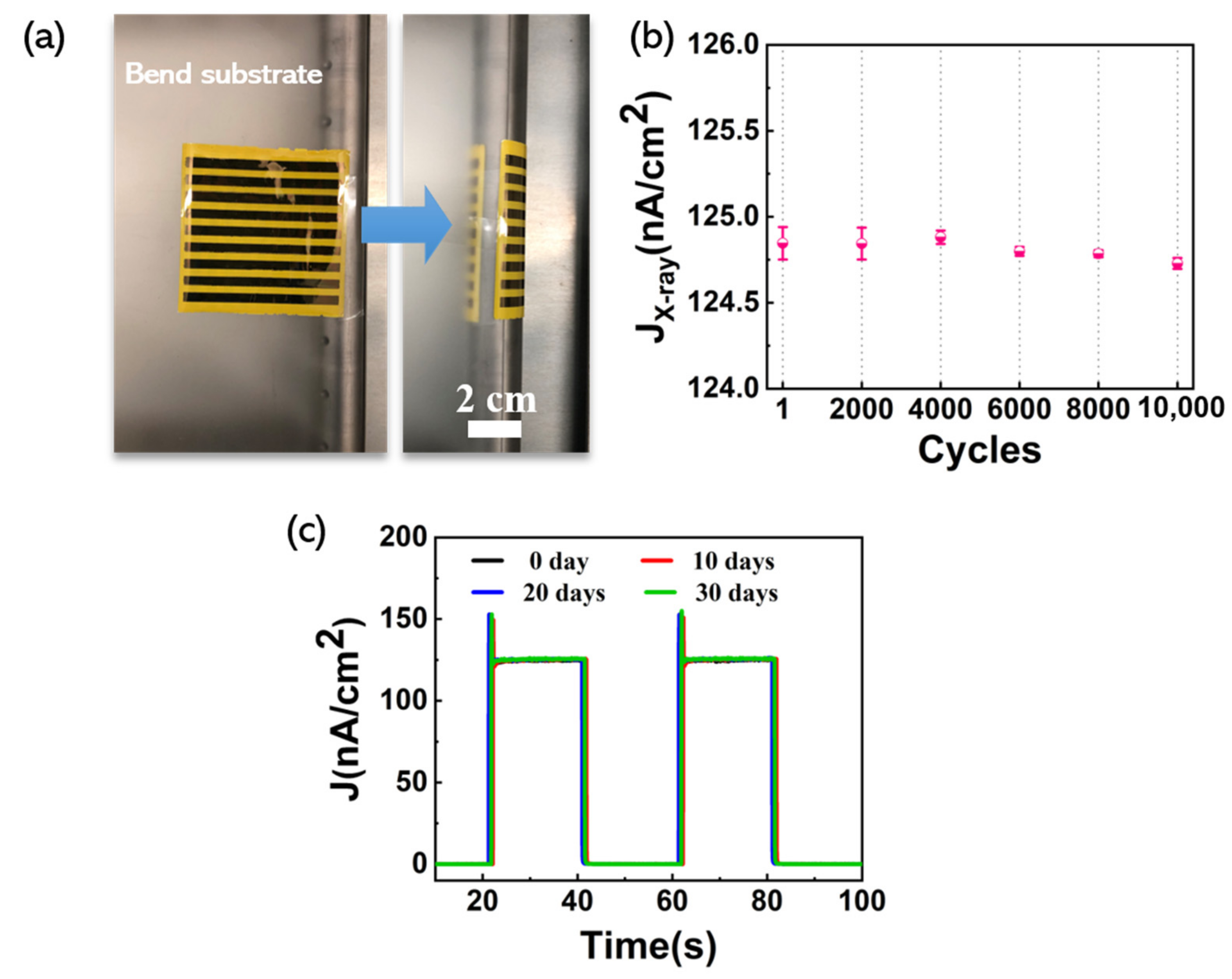A High-Sensitivity Flexible Direct X-ray Detector Based on Bi2O3/PDMS Nanocomposite Thin Film
Abstract
:1. Introduction
2. Materials and Methods
2.1. Materials
2.2. Device Fabrication
2.3. Characterization
3. Results and Discussion
4. Conclusions
Author Contributions
Funding
Institutional Review Board Statement
Informed Consent Statement
Data Availability Statement
Conflicts of Interest
References
- Xu, Q.; Wang, X.; Zhang, H.; Shao, W.; Nie, J.; Guo, Y.; Wang, J.; Ouyang, X. CsPbBr3 Single Crystal X-ray Detector with Schottky Barrier for X-ray Imaging Application. ACS Appl. Electron. Mater. 2020, 2, 879–884. [Google Scholar] [CrossRef]
- Nambiar, S.; Osei, E.K.; Yeow, J.T.W. Polymer nanocomposite-based shielding against diagnostic X-rays. J. Appl. Polym. Sci. 2013, 127, 4939–4946. [Google Scholar] [CrossRef]
- Sakdinawat, A.; Attwood, D. Nanoscale X-ray imaging. Nat. Photonics 2010, 4, 840–848. [Google Scholar] [CrossRef]
- Szeles, C. CdZnTe and CdTe materials for X-ray and gamma ray radiation detector applications. Phys. Status Solidi b 2004, 241, 783–790. [Google Scholar] [CrossRef]
- Kasap, S.; Frey, J.B.; Belev, G.; Tousignant, O.; Mani, H.; Greenspan, J.; Laperriere, L.; Bubon, O.; Reznik, A.; DeCrescenzo, G.; et al. Amorphous and polycrystalline photoconductors for direct conversion flat panel X-ray image sensors. Sensors 2011, 11, 5112–5157. [Google Scholar] [CrossRef] [Green Version]
- Kasap, S.O.; Rowlands, J.A. Review X-ray photoconductors and stabilized a-Se for direct conversion digital flat-panel X-ray image-detectors. J. Mater. Sci. Mater. Electron. 2000, 11, 179–198. [Google Scholar] [CrossRef]
- Owens, A.; Peacock, A. Compound semiconductor radiation detectors. Nucl. Instrum. Methods A 2004, 531, 18–37. [Google Scholar] [CrossRef]
- Yakunin, S.; Sytnyk, M.; Kriegner, D.; Shrestha, S.; Richter, M.; Matt, G.J.; Azimi, H.; Brabec, C.J.; Stangl, J.; Kovalenko, M.V.; et al. Detection of X-ray photons by solution-processed organic-inorganic perovskites. Nat. Photonics 2015, 9, 444–449. [Google Scholar] [CrossRef] [PubMed]
- Morimune, T.; Kajii, H.; Ohmori, Y. Photoresponse Properties of a High-Speed Organic Photodetector Based on Copper–Phthalocyanine Under Red Light Illumination. IEEE Photon. Technol. Lett. 2006, 18, 2662–2664. [Google Scholar] [CrossRef]
- Cowan, S.R.; Wang, J.; Yi, J.; Lee, Y.J.; Olson, D.C.; Hsu, J.W. Intensity and wavelength dependence of bimolecular recombination in P3HT: PCBM solar cells. J. Appl. Phys. 2013, 113, 154504. [Google Scholar] [CrossRef]
- Büchele, P.; Morana, M.; Bagnis, D.; Tedde, S.F.; Hartmann, D.; Fischer, R.; Schmidt, O. Space charge region effects in bidirectional illuminated P3HT:PCBM bulk heterojunction photodetectors. Org. Electron. 2015, 22, 29–34. [Google Scholar] [CrossRef]
- Wei, S.; Yang, M.; Sun, H.; Li, F.; Xiao, F.; Zou, J.; Ren, A.; Huang, Y.; Xiong, Z.; Yuan, L.; et al. Single Crystal CdSe X-ray Detectors with Ultra-High Sensitivity and Low Detection Limit. ACS Appl. Mater. Interfaces 2020. [Google Scholar] [CrossRef] [PubMed]
- Zhang, H.; Wang, F.; Lu, Y.; Sun, Q.; Xu, Y.; Zhang, B.-B.; Jie, W.; Kanatzidis, M.G. High-sensitivity X-ray detectors based on solution-grown caesium lead bromide single crystals. J. Mater. Chem. C 2020, 8, 1248–1256. [Google Scholar] [CrossRef]
- Intaniwet, A.; Mills, C.A.; Shkunov, M.; Sellin, P.J.; Keddie, J.L. Heavy metallic oxide nanoparticles for enhanced sensitivity in semiconducting polymer X-ray detectors. Nanotechnology 2012, 23, 235502. [Google Scholar] [CrossRef] [PubMed] [Green Version]
- Mills, C.A.; Al-Otaibi, H.; Intaniwet, A.; Shkunov, M.; Pani, S.; Keddie, J.L.; Sellin, P.J. Enhanced X-ray detection sensitivity in semiconducting polymer diodes containing metallic nanoparticles. J. Phys. D Appl. Phys. 2013, 46, 275102. [Google Scholar] [CrossRef] [Green Version]
- Demchyshyn, S.; Verdi, M.; Basirico, L.; Ciavatti, A.; Hailegnaw, B.; Cavalcoli, D.; Scharber, M.C.; Sariciftci, N.S.; Kaltenbrunner, M.; Fraboni, B. Designing Ultraflexible Perovskite X-ray Detectors through Interface Engineering. Adv. Sci. 2020, 7, 2002586. [Google Scholar] [CrossRef]
- Thirimanne, H.M.; Jayawardena, K.; Parnell, A.J.; Bandara, R.M.I.; Karalasingam, A.; Pani, S.; Huerdler, J.E.; Lidzey, D.G.; Tedde, S.F.; Nisbet, A.; et al. High sensitivity organic inorganic hybrid X-ray detectors with direct transduction and broadband response. Nat. Commun. 2018, 9, 2926. [Google Scholar] [CrossRef]
- Jayawardena, K.; Thirimanne, H.M.; Tedde, S.F.; Huerdler, J.E.; Parnell, A.J.; Bandara, R.M.I.; Mills, C.A.; Silva, S.R.P. Millimeter-Scale Unipolar Transport in High Sensitivity Organic-Inorganic Semiconductor X-ray Detectors. ACS Nano 2019, 13, 6973–6981. [Google Scholar] [CrossRef]
- Ciavatti, A.; Cramer, T.; Carroli, M.; Basiricò, L.; Fuhrer, R.; De Leeuw, D.M.; Fraboni, B. Dynamics of direct X-ray detection processes in high-Z Bi2O3 nanoparticles-loaded PFO polymer-based diodes. Appl. Phys. Lett. 2017, 111, 183301. [Google Scholar] [CrossRef] [Green Version]
- Zhang, Z.; Yang, G. Recent advancements in using perovskite single crystals for gamma-ray detection. J. Mater. Sci. Mater. Electron. 2020. [Google Scholar] [CrossRef]
- Simon, M.; Ford, R.A.; Franklin, A.R.; Grabowski, S.P.; Menser, B.; Much, G.; Nascetti, A.; Overdick, M.; Powell, M.J.; Wiechert, D.U. Analysis of lead oxide (PbO) layers for direct conversion X-ray detection. IEEE Trans. Nucl. Sci. 2005, 52, 2035–2040. [Google Scholar] [CrossRef]
- Shrestha, S.; Fischer, R.; Matt, G.J.; Feldner, P.; Michel, T.; Osvet, A.; Levchuk, I.; Merle, B.; Golkar, S.; Chen, H.; et al. High-performance direct conversion X-ray detectors based on sintered hybrid lead triiodide perovskite wafers. Nat. Photonics 2017, 11, 436–440. [Google Scholar] [CrossRef]
- Qamar, A.; LeBlanc, K.; Semeniuk, O.; Reznik, A.; Lin, J.; Pan, Y.; Moewes, A. X-ray spectroscopic study of amorphous and polycrystalline PbO films, alpha-PbO, and beta-PbO for direct conversion imaging. Sci. Rep. 2017, 7, 13159. [Google Scholar] [CrossRef]
- Wei, H.; Fang, Y.; Mulligan, P.; Chuirazzi, W.; Fang, H.-H.; Wang, C.; Ecker, B.R.; Gao, Y.; Loi, M.A.; Cao, L.; et al. Sensitive X-ray detectors made of methylammonium lead tribromide perovskite single crystals. Nat. Photonics 2016, 10, 333–339. [Google Scholar] [CrossRef]
- Pan, W.; Wu, H.; Luo, J.; Deng, Z.; Ge, C.; Chen, C.; Jiang, X.; Yin, W.-J.; Niu, G.; Zhu, L.; et al. Cs2AgBiBr6 single-crystal X-ray detectors with a low detection limit. Nat. Photonics 2017, 11, 726–732. [Google Scholar] [CrossRef]
- Hiyama, F.; Noguchi, T.; Koshimizu, M.; Kishimoto, S.; Haruki, R.; Nishikido, F.; Fujimoto, Y.; Aida, T.; Takami, S.; Adschiri, T.; et al. X-ray detection properties of plastic scintillators containing surface-modified Bi2O3 nanoparticles. Jpn. J. Appl. Phys. 2018, 57, 052203. [Google Scholar] [CrossRef]
- Yao, L.; Niu, G.; Yin, L.; Du, X.; Lin, Y.; Den, X.; Zhang, J.; Tang, J. Bismuth halide perovskite derivatives for direct X-ray detection. J. Mater. Chem. C 2020, 8, 1239–1243. [Google Scholar] [CrossRef]
- Jagdale, P.; Rovere, M.; Ronca, R.; Vigneri, C.; Bernardini, F.; Calzetta, G.; Tagliaferro, A. Determination of the X-ray attenuation coefficient of bismuth oxychloride nanoplates in polydimethylsiloxane. J. Mater. Sci. 2020, 55, 7095–7105. [Google Scholar] [CrossRef]
- Praveenkumar, P.; Venkatasubbu, G.D.; Thangadurai, P.; Prakash, T. Nanocrystalline bismuth oxyiodides thick films for X-ray detector. Mat. Sci. Semicon. Proc. 2019, 104, 104686. [Google Scholar] [CrossRef]
- Shamaila, S.; Sajjad, A.K.L.; Chen, F.; Zhang, J. Study on highly visible light active Bi2O3 loaded ordered mesoporous titania. Appl. Catal. B 2010, 94, 272–280. [Google Scholar] [CrossRef]
- Jayakumar, S.; Saravanan, T.; Philip, J. Thermal Stability and X-ray Attenuation Studies on alpha-Bi2O3, beta-Bi2O3 and Bi Based Nanocomposites for Radiopaque Fabrics. J. Nanosci. Nanotechnol. 2018, 18, 3969–3981. [Google Scholar] [CrossRef]
- Keum, C.; Murawski, C.; Archer, E.; Kwon, S.; Mischok, A.; Gather, M.C. A substrateless, flexible, and water-resistant organic light-emitting diode. Nat. Commun. 2020, 11, 6250. [Google Scholar] [CrossRef] [PubMed]
- Zhang, Z.; Chen, L.; Yang, X.; Li, T.; Chen, X.; Li, X.; Zhao, T.; Zhang, J. Enhanced Flexible Piezoelectric Sensor by the Integration of P(VDF-TrFE)/AgNWs Film With a-IGZO TFT. IEEE Electron Device Lett. 2018. [Google Scholar] [CrossRef]
- Liu, Y.; Sun, N.; Liu, J.; Wen, Z.; Sun, X.; Lee, S.T.; Sun, B. Integrating a Silicon Solar Cell with a Triboelectric Nanogenerator via a Mutual Electrode for Harvesting Energy from Sunlight and Raindrops. ACS Nano 2018, 12, 2893–2899. [Google Scholar] [CrossRef]
- Qiu, Q.; Chen, H.; You, Z.; Feng, Y.; Wang, X.; Wang, Y.; Ying, Y. Shear Exfoliated Metal-Organic Framework Nanosheet-Enabled Flexible Sensor for Real-Time Monitoring of Superoxide Anion. ACS Appl. Mater. Interfaces 2020, 12, 5429–5436. [Google Scholar] [CrossRef]
- Cramer, T.; Sacchetti, A.; Lobato, M.T.; Pedro, B.; Vincent, F.; Mohamed, B.; Jacquelin, B.; Elvira, F.; Rodrigo, M.; Beatrice, F. Radiation-Tolerant Flexible Large-Area Electronics Based on Oxide Semiconductors. Adv. Electron. Mater. 2016, 2, 1500489. [Google Scholar] [CrossRef]
- Cramer, T.; Fratelli, I.; Barquinha, P.; Ann, S.; Cristina, F.; Frank, D.; Christophe, L.; Rodrigo, M.; Elvira, F.; Beatric, F. Passive radiofrequency X-ray dosimeter tag based on flexible radiation-sensitive oxide field-effect transistor. Sci. Adv. 2018, 46, eaat1825. [Google Scholar] [CrossRef] [Green Version]
- Ouyang, W.; Chen, J.; He, J.H.; Fang, X. Improved Photoelectric Performance of UV Photodetector Based on ZnO Nanoparticle-Decorated BiOCl Nanosheet Arrays onto PDMS Substrate: The Heterojunction and Ti3C2Tx MXene Conduction Layer. Adv. Electron. Mater. 2020, 6, 2000168. [Google Scholar] [CrossRef]
- Sabri, F.; Sebelik, M.E.; Meacham, R.; Boughter, J.D., Jr.; Challis, M.J.; Leventis, N. In vivo ultrasonic detection of polyurea crosslinked silica aerogel implants. PLoS ONE 2013, 8, e66348. [Google Scholar] [CrossRef] [Green Version]
- Allison, S.W.; Baker, E.S.; Lynch, K.J.; Sabri, F. In Vivo X-ray Imaging of Phosphor-Doped PDMS and Phosphor-Doped Aerogel Biomaterials. Int. J. Polym. Mater. Polym. Biomater. 2015, 64, 823–830. [Google Scholar] [CrossRef]
- Massaro, A.; Spano, F.; Cingolani, R.; Athanassiou, A. Experimental Optical Characterization and Polymeric Layouts of Gold PDMS Nanocomposite Sensor for Liquid Detection. IEEE Sens. J. 2011, 11, 1780–1786. [Google Scholar] [CrossRef]
- Wang, X.; Yang, B.; Liu, J.; Zhu, Y.; Yang, C.; He, Q. A flexible triboelectric-piezoelectric hybrid nanogenerator based on P(VDF-TrFE) nanofibers and PDMS/MWCNT for wearable devices. Sci. Rep. 2016, 6. [Google Scholar] [CrossRef] [Green Version]
- Sriphan, S.; Charoonsuk, T.; Maluangnont, T.; Vittayakorn, N. High-Performance Hybridized Composited-Based Piezoelectric and Triboelectric Nanogenerators Based on BaTiO3/PDMS Composite Film Modified with Ti0.8O2 Nanosheets and Silver Nanopowders Cofillers. ACS Appl. Energy Mater. 2019, 2, 3840–3850. [Google Scholar] [CrossRef]
- Ammar, S.; Ramesh, K.; Vengadaesvaran, B.; Ramesh, S.; Arof, A.K. Amelioration of anticorrosion and hydrophobic properties of epoxy/PDMS composite coatings containing nano ZnO particles. Prog. Org. Coat. 2016, 92, 54–65. [Google Scholar] [CrossRef]
- Xie, J.; Hu, J.; Lin, X.; Fang, L.; Wu, F.; Liao, X.; Luo, H.; Shi, L. Robust and anti-corrosive PDMS/SiO2 superhydrophobic coatings fabricated on magnesium alloys with different-sized SiO2 nanoparticles. Appl. Surf. Sci. 2018, 457, 870–880. [Google Scholar] [CrossRef]
- Kim, Y.H.; Sachse, C.; Machala, M.L.; May, C.; Müller-Meskamp, L.; Leo, K. Highly Conductive PEDOT:PSS Electrode with Optimized Solvent and Thermal Post-Treatment for ITO-Free Organic Solar Cells. Adv. Funct. Mater. 2011, 21, 1076–1081. [Google Scholar] [CrossRef]
- Kang, J.; Sangwan, V.K.; Lee, H.-S.; Liu, X.; Hersam, M.C. Solution-Processed Layered Gallium Telluride Thin-Film Photodetectors. ACS Photonics 2018. [Google Scholar] [CrossRef]
- Basirico, L.; Ciavatti, A.; Cramer, T.; Cosseddu, P.; Bonfiglio, A.; Fraboni, B. Direct X-ray photoconversion in flexible organic thin film devices operated below 1 V. Nat. Commun. 2016, 7, 13063. [Google Scholar] [CrossRef] [Green Version]
- Liang, H.; Cui, S.; Su, R.; Guan, P.; He, Y.; Yang, L.; Chen, L.; Zhang, Y.; Mei, Z.; Du, X. Flexible X-ray Detectors Based on Amorphous Ga2O3 Thin Films. ACS Photonics 2018, 6, 351–359. [Google Scholar] [CrossRef]
- Liu, J.; Shabbir, B.; Wang, C.; Wan, T.; Ou, Q.; Yu, P.; Tadich, A.; Jiao, X.; Chu, D.; Qi, D.; et al. Flexible, Printable Soft-X-ray Detectors Based on All-Inorganic Perovskite Quantum Dots. Adv. Mater. 2019, 31, e1901644. [Google Scholar] [CrossRef]
- Chen, J.; Tang, H.; Liu, B.; Zhu, Z.; Gu, M.; Zhang, Z.; Xu, Q.; Xu, J.; Zhou, L.; Chen, L.; et al. High-Performance X-ray Detector Based on Single-Crystal beta-Ga2O3:Mg. ACS Appl. Mater. Interfaces 2021. [Google Scholar] [CrossRef]
- Lai, S.; Cosseddu, P.; Basiricò, L.; Ciavatti, A.; Fraboni, B.; Bonfiglio, A. A Highly Sensitive, Direct X-ray Detector Based on a Low-Voltage Organic Field-Effect Transistor. Adv. Electron. Mater. 2017, 3, 1600409. [Google Scholar] [CrossRef]







| Sample Name | Bi2O3 in the Dry Film | |
|---|---|---|
| Weight Ratio % | Weight Percent % | |
| β-10% | 10 | 9.1 |
| β-30% | 30 | 23.1 |
| β-50% | 50 | 33.3 |
| β-70% | 70 | 41.2 |
| β-90% | 90 | 47.4 |
| β-110% | 110 | 52.4 |
| Rotational Speed (rpm) | 1000 | 2000 | 4000 | 5000 | 8000 |
| Thickness (μm) | 290 | 100 | 52 | 40 | 16 |
| Materials | Sensitivity (μC Gyair−1 cm−2) | Voltage (V) | Thickness (μm) | Dose Rate 1 (μGyair s−1) | Reference |
|---|---|---|---|---|---|
| CsPbBr | 17.7 | 0.1 | 1000 | 17.2 | [50] |
| a-Se | 20 | 2000 | 200 | - | [9] |
| β-Ga2O3 | 66 | −15 | 400 | 695 | [51] |
| PTAA:Bi2O3 NPs | 0.4 2 | −200 | 20 | 13,000 | [14] |
| TIPS-pentacence | 4.8 | −3 | 0.1 | 6500 | [52] |
| PFO:Bi2O3 NPs | 24 | −80 | 1 | 20,000 | [19] |
| PDMS:Bi2O3 NPs | 203.58 | 150 | 290 | 23.90 | this work |
Publisher’s Note: MDPI stays neutral with regard to jurisdictional claims in published maps and institutional affiliations. |
© 2021 by the authors. Licensee MDPI, Basel, Switzerland. This article is an open access article distributed under the terms and conditions of the Creative Commons Attribution (CC BY) license (https://creativecommons.org/licenses/by/4.0/).
Share and Cite
Mao, L.; Li, Y.; Chen, H.; Yu, L.; Zhang, J. A High-Sensitivity Flexible Direct X-ray Detector Based on Bi2O3/PDMS Nanocomposite Thin Film. Nanomaterials 2021, 11, 1832. https://doi.org/10.3390/nano11071832
Mao L, Li Y, Chen H, Yu L, Zhang J. A High-Sensitivity Flexible Direct X-ray Detector Based on Bi2O3/PDMS Nanocomposite Thin Film. Nanomaterials. 2021; 11(7):1832. https://doi.org/10.3390/nano11071832
Chicago/Turabian StyleMao, Longmei, Yi Li, Hu Chen, Longxin Yu, and Jianhua Zhang. 2021. "A High-Sensitivity Flexible Direct X-ray Detector Based on Bi2O3/PDMS Nanocomposite Thin Film" Nanomaterials 11, no. 7: 1832. https://doi.org/10.3390/nano11071832
APA StyleMao, L., Li, Y., Chen, H., Yu, L., & Zhang, J. (2021). A High-Sensitivity Flexible Direct X-ray Detector Based on Bi2O3/PDMS Nanocomposite Thin Film. Nanomaterials, 11(7), 1832. https://doi.org/10.3390/nano11071832





